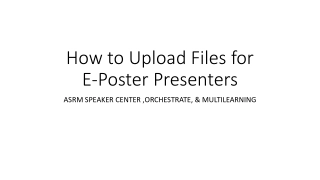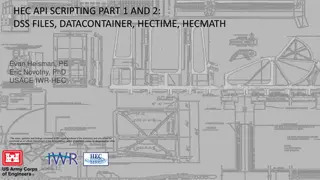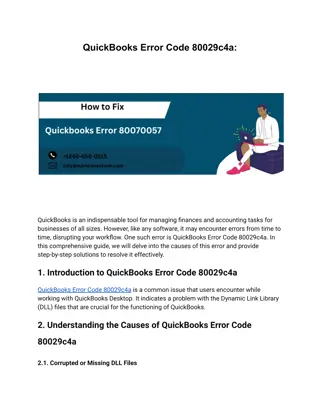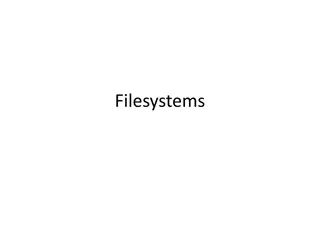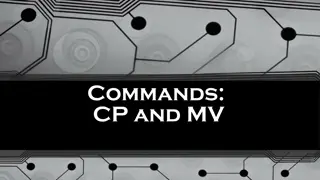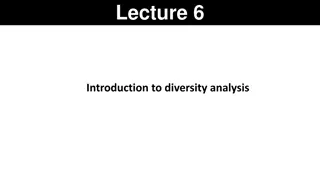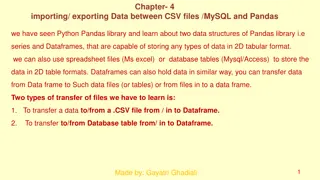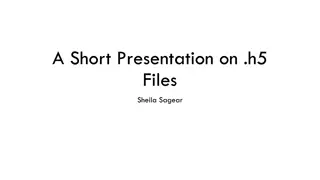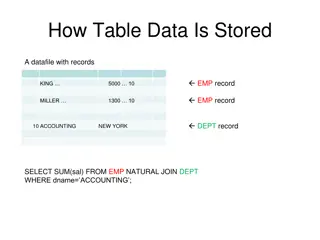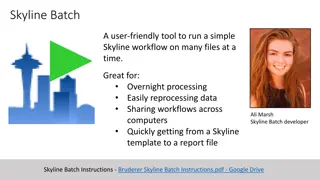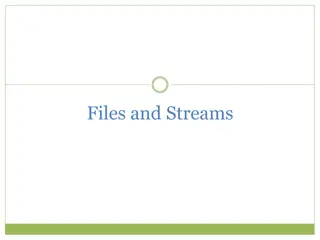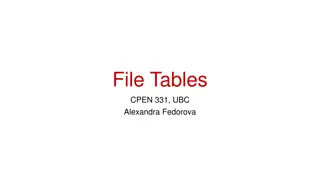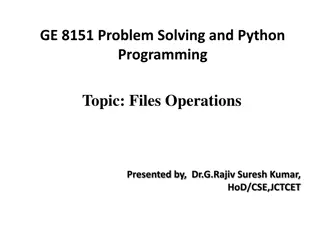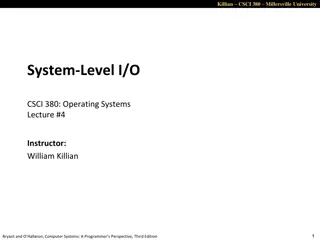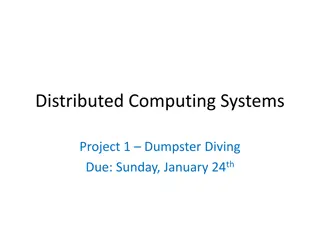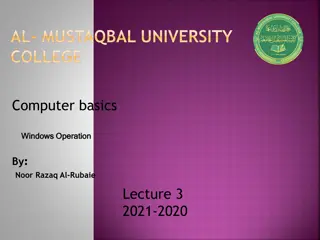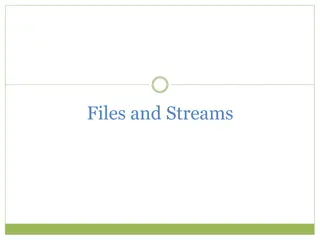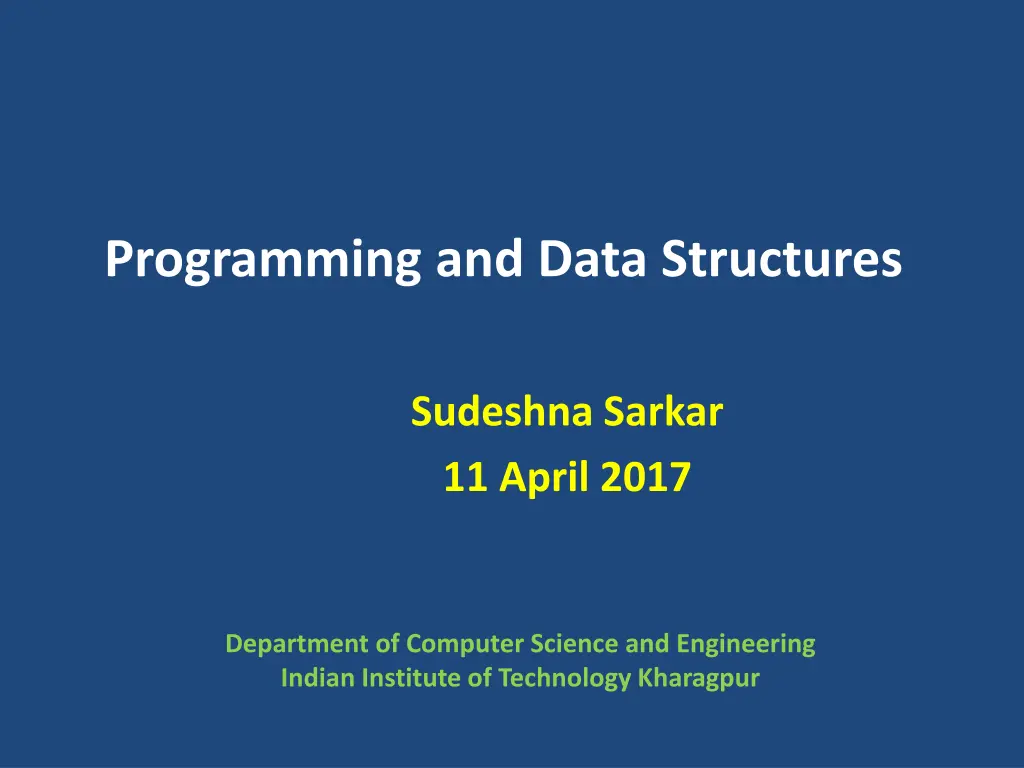
Programming and Data Structures with Sudeshna Sarkar at IIT Kharagpur
"Explore a complete C program covering command-line arguments, passing parameters to main, and compilation and execution. Learn about arrays of strings, syntax errors, and more at the Indian Institute of Technology, Kharagpur."
Download Presentation

Please find below an Image/Link to download the presentation.
The content on the website is provided AS IS for your information and personal use only. It may not be sold, licensed, or shared on other websites without obtaining consent from the author. If you encounter any issues during the download, it is possible that the publisher has removed the file from their server.
You are allowed to download the files provided on this website for personal or commercial use, subject to the condition that they are used lawfully. All files are the property of their respective owners.
The content on the website is provided AS IS for your information and personal use only. It may not be sold, licensed, or shared on other websites without obtaining consent from the author.
E N D
Presentation Transcript
Programming and Data Structures Sudeshna Sarkar 11 April 2017 Department of Computer Science and Engineering Indian Institute of Technology Kharagpur
A complete C program /* prog.c */ #include <stdio.h> void PRINT() { } void PRINT(); void PRINT_I(int); void PRINT_F(float,float); printf( Hello Everybody!!!\n ); void PRINT_I(int b) { } void main() { } printf( %d \n ,b); int a=10; float x,y; scanf( %d %d ,&x,&y); PRINT(); PRINT_I(a); PRINT_F(x,y); void PRINT_F(float p, float q) { printf( %2.1f %2.2f \n ,p,q); }
Compilation and Execution $ cc Wall prog.c $ $ ./a.out 2.34 3.45 Hello Everybody!!! 10 2.3 3.45 $
A complete C program /* prog.c */ #include <stdio.h> void PRINT() { } void PRINT(); void PRINT_I(int); void PRINT_F(float,float); printf( Hello Everybody!!!\n ); void PRINT_I(int b) { } void main(????) { } printf( %d \n ,b); int a=10; float x,y; scanf( %d %d ,&x,&y); PRINT(); PRINT_I(a); PRINT_F(x,y); void PRINT_F(float p, float q) { printf( %2.1f %2.2f \n ,p,q); }
Command Line Arguments Command line arguments may be passed by specifying them under main( ). int main(int argc, char *argv[ ]); Argument Count Array of Strings as command line arguments including the command itself.
Passing parameters to main() #include <stdio.h> $ cc -Wall wk13_commandline.c $ ./a.out 0: ./a.out $ ./a.out HI 0: ./a.out 1: HI $ ./a.out Indian Institute of Technology 0: ./a.out 1: Indian 2: Institute 3: of 4: Technology int main(int argc, char *argv[]) { int i; for(i=0;i<argc;i++) { printf("%d: %s\n",i,argv[i]); } return 0; }
Passing parameters to main() #include <stdio.h> $ time ./a.out Indian Institute of Technology 0: ./a.out 1: Indian 2: Institute 3: of 4: Technology int main(int argc, char *argv[]) { int i; for(i=0;i<argc;i++) { printf("%d: %s\n",i,argv[i]); } real 0m0.002s user 0m0.001s sys 0m0.001s return 0; }
Passing parameters to main() #include <stdio.h> $ ./a.out Anirban 21 8.3 0: ./a.out 1: Anirban 2: 21 3: 8.3 int main(int argc, char *argv[]) { int i; for(i=0;i<argc;i++) { printf("%d: %s\n",i,argv[i]); } ./a.out Anirban 21 8.3 return 0; } argc=4 ./a.out Anirban 21 8.3 argv
Library function sscanf() Header file: #include <stdio.h> Function prototype: int sscanf(const char *str, const char *format, ...); Conversion character is same as scanf().
Passing parameters to main() #include <stdio.h> int main(int argc, char *argv[]) { char name[20]; int age; float cgpa; #include <stdio.h> int main(int argc, char *argv[]) { int i; for(i=0;i<argc;i++) { printf("%d: %s\n",i,argv[i]); } return 0; } sscanf(argv[1],"%s",name); sscanf(argv[2],"%d",&age); sscanf(argv[3],"%f",&cgpa); printf("%s %d %f\n", return 0; } name,age,cgpa); $ ./a.out Anirban 21 8.3 0: ./a.out 1: Anirban 2: 21 3: 8.3 $ $ ./a.out Anirban 21 8.3 Anirban 21 8.300000 $
Functions to convert strings to numbers Once we've got a string with a number in it (either from a file or from the user typing) we can use atoi or atof to convert it to a number The functions are part of header file stdlib.h char numberstring[]= "3.14"; int i; double pi; pi= atof (numberstring); i= atoi ("12"); Both of these functions return 0 if they have a problem
Example: Average from Command Line #include <stdio.h> #include <stdlib.h> $ ./a.out 45 239 123 Average=135.666667 $ int main(int argc,char *argv[]) { float sum=0; int i,num; num=argc-1; for(i=1;i<=num;i++) sum+=atof(argv[i]); printf("Average=%f \n",sum/(float) num); return 0; }
Passing parameters to main() Two parameters will be passed to function main() through command line argc and argv. Name of the parameters are fixed. argc is of integer type and it stores the number of parameters (delimited by space) in the command line. argv is a 2D array of characters and it stores all the words in the command line. By default all the parameters are taken as array of characters (strings) that can be converted to other data types.
Advantages of File handling At times size of the program input is very large. During the testing phase providing inputs in the interactive way is tedious. The size of the program output may be large enough and will not fit in a single screen. You may wish to store the output for future analysis.
File handling in C A file needs to be opened first for any input/output operations on the file. It may be opened for reading/writing/appending. The file must be closed once the use/handling of the file is over. In between the address of the file will be stored in a pointer data type viz., FILE *.
File handling in C In C we use FILE * to represent a pointer to a file. fopen is used to open a file. It returns a pointer to the file if successfully opened the file else it returns NULL. FILE *fptr; char filename[]= "file2.dat"; fptr= fopen (filename,"w"); if (fptr == NULL) { printf ( ERROR IN FILE CREATION ); /* DO SOMETHING */ }
exit() function Sometimes error checking means we want an "emergency exit" from a program. We want it to stop dead. In main we can use "return" to stop. In functions we can use exit to do this. Library file stdlib.h is the header file for exit() function. FILE *fptr; char filename[]= "file2.dat"; fptr= fopen (filename,"w"); if (fptr == NULL) { printf ( ERROR IN FILE CREATION ); exit(-1); }
Modes for opening files The second argument of fopen is the mode in which we open the file. "r" opens a file for reading. "w" creates a file for writing - and writes over all previous contents (deletes the file so be careful!). "a" opens a file for appending - writing on the end of the file.
Closing a file We can close a file simply using fclose() and the file pointer. FILE *fptr; char filename[]= "myfile.dat"; fptr= fopen (filename,"w"); if (fptr == NULL) { printf ("Cannot open file to write!\n"); exit(-1); } fprintf (fptr,"Hello World of filing!\n"); fclose (fptr); Opening Access closing
Writing to a file using fprintf( ) fprintf( ) works just like printf and sprintf except that its first argument is a file pointer. FILE *fptr; fptr= fopen ("file.dat","w"); /* Check it's open */ fprintf (fptr,"Hello World!\n");
Reading Data Using fscanf( ) FILE *fptr; fptr= fopen ( input.dat , r ); /* Check it's open */ if (fptr==NULL) { printf( Error in opening file \n ); } fscanf(fptr, %d%d ,&x,&y); input.dat 20 30 x=20 y=30
Reading lines from a file using We can read a string using fgets(). FILE *fptr; char line [1000]; /* Open file and check it is open */ while (fgets(line,1000,fptr) != NULL) { printf ("Read line %s\n",line); } fgets() takes 3 arguments, a string, a maximum number of characters to read and a file pointer. It returns NULL if there is an error (such as EOF).
Check whether a matrix is symmetric or not V1 int main() { char symm='y'; int i,j,size,mat[1000][1000]; #include <stdio.h> int ReadMat(int mat[1000][1000]) { int i,j,size; size=ReadMat(mat); for(i=0;i<size;i++) { for(j=i+1;j<size;j++) { if(mat[i][j]!=mat[j][i]) symm='n'; break; } if(symm=='n') break; } if(symm=='y') printf("Symmetrix Matrix\n"); else printf("Not Symmetric"); return 0; } printf( Matrix size? : \n"); scanf("%d",&size); for(i=0;i<size;i++) for(j=0;j<size;j++) scanf("%d",&mat[i][j]); return size; }
Check whether a matrix is symmetric or not V2 int main() { char symm='y'; int i,j,size,mat[1000][1000]; #include <stdio.h> int ReadMat(int mat[1000][1000]) { int i,j,size; FILE *fp; size=ReadMat(mat); for(i=0;i<size;i++) { for(j=i+1;j<size;j++) { if(mat[i][j]!=mat[j][i]) symm='n'; break; } if(symm=='n') break; } if(symm=='y') printf("Symmetrix Matrix\n"); else printf("Not Symmetric"); return 0; } fp=fopen("Matrix.txt","r"); // printf( Matrix size: \n"); fscanf(fp,"%d",&size); for(i=0;i<size;i++) for(j=0;j<size;j++) fscanf(fp,"%d",&mat[i][j]); fclose(fp); return size; }
Check whether a matrix is symmetric or not V3 int main() { char symm='y'; int i,j,size,mat[1000][1000]; #include <stdio.h> int ReadMat(int mat[1000][1000]) { char filename[100]; int i,j,size; FILE *fp; scanf( %s ,filename); fp=fopen(filename,"r"); // printf( Matrix size: \n"); fscanf(fp,"%d",&size); for(i=0;i<size;i++) for(j=0;j<size;j++) fscanf(fp,"%d",&mat[i][j]); size=ReadMat(mat); for(i=0;i<size;i++) { for(j=i+1;j<size;j++) { if(mat[i][j]!=mat[j][i]) symm='n'; break; } if(symm=='n') break; } if(symm=='y') printf("Symmetrix Matrix\n"); else printf("Not Symmetric"); return 0; } fclose(fp); return size; }
Check whether a matrix is symmetric or not V4 int main(int argc, char *argv[]) { char symm='y'; int i,j,size,mat[1000][1000]; #include <stdio.h> int ReadMat(char filename, int mat[1000][1000]) { int i,j,size; FILE *fp; fp=fopen(filename,"r"); // printf( Matrix size: \n"); fscanf(fp,"%d",&size); for(i=0;i<size;i++) for(j=0;j<size;j++) fscanf(fp,"%d",&mat[i][j]); size=ReadMat(argv[1],mat); for(i=0;i<size;i++) { for(j=i+1;j<size;j++) { if(mat[i][j]!=mat[j][i]) symm='n'; break; } if(symm=='n') break; } if(symm=='y') printf("Symmetrix Matrix\n"); else printf("Not Symmetric"); return 0; } fclose(fp); return size; }
Check whether a matrix is symmetric or not V5 int main(int argc, char *argv[]) { char symm='y'; int i,j,size,**mat; #include <stdio.h> int ReadMat(char filename, int **mat) { .. . } return 0; }
Balanced Symbol Checking In processing programs and working with computer languages there are many instances when symbols must be balanced { } , [ ] , ( ) Write a program that will take a C program file as command line input and prints whether all the parenthesis, curly and square brackets that are opened has closed or not.
Balanced Symbol Checking while(line[i]!='\0') { switch(line[i]) { case '(': pbracket++; break; case ')': pbracket--; break; case '{': cbracket++; break; case '}': cbracket--; break; case '[': sbracket++; break; case ']': sbracket--; break; } i++; } } fclose(fp); if(pbracket==0) printf("Parentesis Open-Close.\n"); else printf("Parentesis Mismatches.\n"); if(cbracket==0) printf("Curly Open-Close.\n"); else printf("Curly Mismatches.\n"); if(sbracket==0) printf("Square Open-Close.\n"); else printf("Square Mismatches.\n"); return 0; } #include <stdio.h> #include <stdlib.h> int main(int argc, char *argv[]) { FILE *fp; char line[500]; int i,pbracket,cbracket,sbracket; fp=fopen(argv[1],"r"); if(fp==NULL) { printf("File opening error... exiting"); exit(0); } pbracket=cbracket=sbracket=0; while(!feof(fp)) { fgets(line,100,fp); i=0; Did file open properly? File end is not reached.
Balanced Symbol Checking In processing programs and working with computer languages there are many instances when symbols must be balanced { } , [ ] , ( ) Following C syntax: - { } [] () . is allowed - { [ } ] ( ) is not allowed.
Algorithm: Balanced Symbol Checking Homework Write a C program that will take any C program as command line input and will report any syntax error due to balancing in bracket symbols. Make an empty stack Read characters until end of file If a symbol is an opening symbol push it onto the stack If a symbol is a closing symbol pop the stack if the stack is empty report an error if the popped symbol does not match the closing symbol report an error If the stack is empty report symbols are balanced. Else report an error
Three special I/O streams Three special file streams are defined in the <stdio.h> header stdin reads input from the keyboard stdout send output to the screen stderr prints errors to an error device (usually also the screen) What might this do? fprintf (stdout,"Hello World!\n");
An example program #include <stdio.h> int main() { int i; } fprintf(stdout,"Give value of i \n"); fscanf(stdin,"%d",&i); fprintf(stdout,"Value of i=%d \n",i); fprintf(stderr,"No error: But an example to show error message.\n"); return 0; $ ./a.out Give value of i 15 Value of i=15 No error: But an example to show error message. $ Display on the screen
Input File & Output File redirection One may redirect the input and output files to other files (other than stdin and stdout). Usage: Suppose the executable file is a.out $ ./a.out <in.dat >out.dat No error: But an example to show error message. Give value of i Value of i=15 Display screen 15 in.dat out.dat
Example 1:Reverse a stack using recursion You are not allowed to use loop constructs like while, for.. etc top top 4 3 2 1 Sample input: 1 2 3 4 Sample output: 4 3 2 1 1 2 3 4
Example 2: Sort a stack using recursion You are not allowed to use loop constructs like while, for.. etc top top 30 -5 18 14 Sample input: 14 18 -5 30 Sample output: 30 18 14 -5 -5 14 18 30
Example 3: Implementation of Merging operation in Merge Sort using Stacks top top -5 14 18 30 -9 -3 56 90 top -9 -5 -3 14 18 30 56 90
Example 4: Given a stack, print the Next Greater Element (NGE) for every element. For any stack the bottom most element always has next greater element as -1 For a stack which is sorted in decreasing order, all elements have next greater element as -1. For the input stack [4, 5, 2, 25], the next greater elements for each element are as follows. Element 4 5 2 25 NGE 5 25 25 -1
Example 5: Implement a Stack using a Linked List top -9 -3 56 90 head 56 90 -3 -9
Example 6: Print first N Fibonacci Numbers using a Queue The queue initially contains 0 and 1 front rear 1 0
Example 7: Use a Stack to reverse a Queue top rear front 14 18 -5 30 30 -5 18 14 rear front 14 18 -5 30
Example 8: Create a new Queue with given elements appended at the end of the Queue in a reverse order * Hint- You can use a stack in order to achieve the outcome rear front 30 -5 18 14 front rear 14 18 -5 30 30 -5 18 14
Example 9: Implement a Stack using a Queue data structure For a given stack create a same size array which you are going to use as a Queue. Push and pop operation of stack s should be emulated with the Enqueue and Dequeue operation. You can use an intermediate Queue for the above implementation.
Example 10: Implement a Queue using a Linked List rear front 30 -5 18 14 head -5 30 18 14
Question Can you implement a queue using two stacks? If yes do it. If no explain why. Can you implement a stack using two queues? If yes do it. If no explain why.
End Semester Exam Syllabus: From first class upto this class. DO NOT forget to mention your section number. That may lead to mistake in tabulation (you are marked as absent in the grade sheet) DO NOT use pencil for answering questions.

